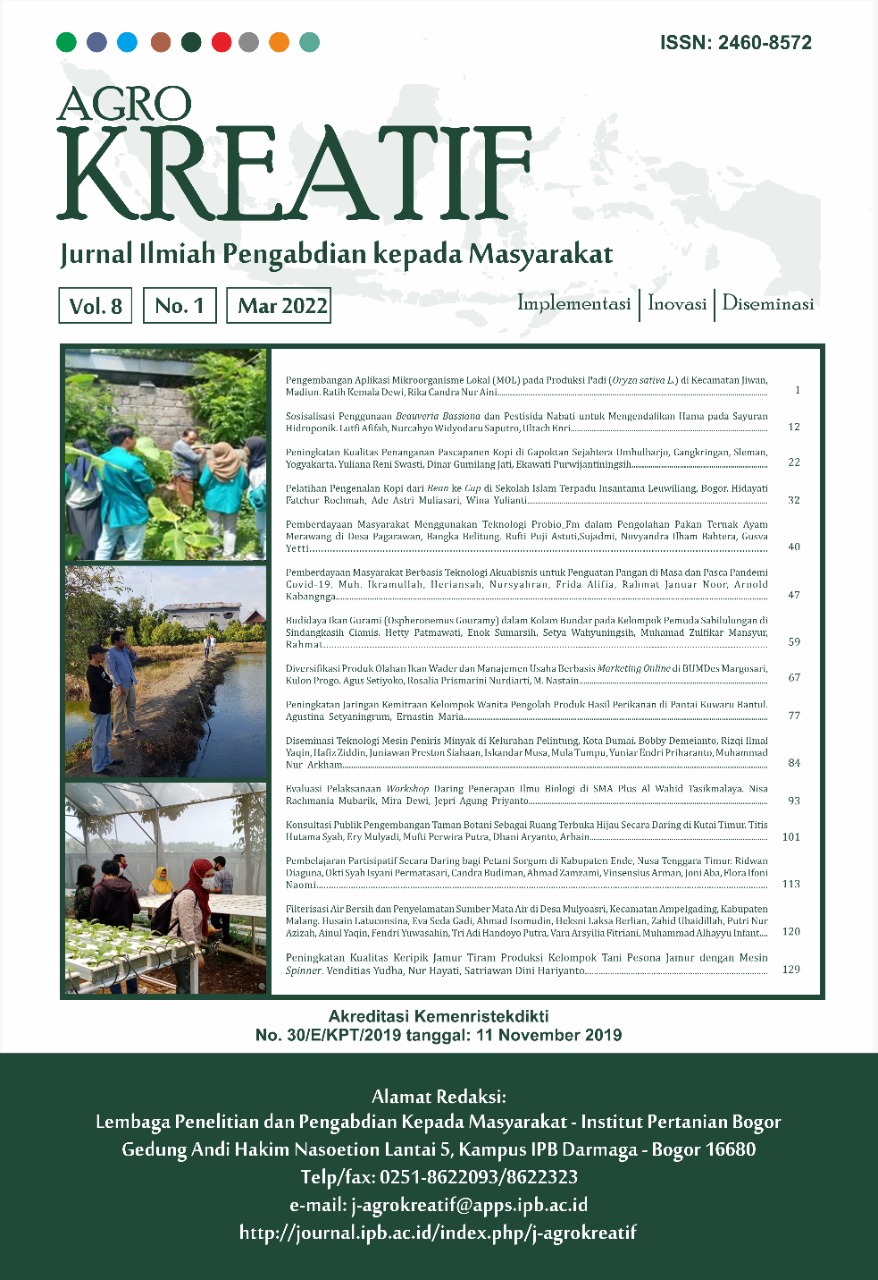Budidaya Ikan Gurami (Ospheronemus Gouramy) dalam Kolam Bundar pada Kelompok Pemuda Sabilulungan di Sindangkasih Ciamis
Abstract
This activity aims to improve the knowledge and skills of gourami cultivators in Sindangkasih Village, Sindangkasih District, Ciamis Regency, and to understand the benefits of circular ponds as technology in gourami cultivation to increase the quality and quantity of gourami production. The method of carrying out activities through several stages, namely: Preparation & coordination; Implementation; Monitoring and evaluation. The implementation stage begins by providing counselling regarding the cultivation of gourami in circular ponds, followed by the provision of circular ponds as another option for cultivation so that the cultivators do not experience many losses. As a result of the activity, the cultivators switched to circular ponds. Hence, water quality is more controlled, stocking density, more efficient and effective feeding, there are no dead spots in circular ponds so that fish is always moving. Dirt is not concentrated in one point and, pests can be tackled faster because water is controlled, and pests are quickly controlled, the mortality rate is low. As a result, the maximum yield of gourami fish is within four months. The circular ponds are different from conventional ponds, where water conditions are not optimally controlled so that pests cannot be predicted and are slow in pest management so that the mortality rate is high.
Downloads
References
Ahmad N, Martudi S, Dawami. 2017. Pengaruh Kadar Protein yang Berbeda terhadap Pertumbuhan Ikan Gurami (Osphronemus gouramy). Jurnal Agroqua. 15(2): 51‒58.
Andhika WP, Fajar B, Tristiana Y. 2016. Pengaruh Penambahan Recombinant Growth Hormone (RGH) pada pakan dengan kadar protein tinggi terhadap pertumbuhan dan tingkat kelulushidupan benih ikan gurami (Osphronemus gouramy). Journal of Aquaculture Management and Technology. 5(1): 17‒25.
Bachtiar Y. 2010. Buku Pintar Budi Daya & Bisnis Gurami. Jakarta (ID): Agromedia Pustaka.
Jumaidi A, Yulianto H, Efendi E. 2016. Pengaruh Debit Air Terhadap Perbaikan Kualitas Air pada Sistem Resirkulasi dan Hubungannya dengan Sintasan dan Pertumbuhan Benih Ikan Gurami (Osphronemus gouramy). e-Jurnal Rekayasa dan Teknologi BudidayaPerairan. 5(2): 587‒596.
Karel M, Hilyana S, Lestari DP. 2019. Pengaruh Penambahan Probiotik EM4 (Effective Microorganism) Dengan Dosis yang Berbeda pada Pakan Terhadap Hubungan Panjang dan Berat Ikan Mas (Cryprinus carpio). Jurnal Perikanan. 9(2): 125‒129. https://doi.org/10.29303/jp.v9i2.148
Kottelat MAJ, Whitten AJ. 1993. Freshwater fishes of western Indonesia and Sulawesi. Jakarta (ID): Periplus Editions Limited.
Luthfi A, Diana R, Istiyanto S. 2016. Pemanfaatan Tepung Hasil Fermentasi Azolla (Azolla microphylla) Sebagai Campuran Pakan Buatan untuk Meningkatkan Pertumbuhan dan Kelulushidupan Ikan Gurami (Osphronemus gouramy). Journal of Aquaculture Management and Technology. 5(1): 1‒7.
Marilin K, Sulantiwi. 2015. Sistem Pendukung Keputusan Menentukan Kualitas Bibit Ikan Gurami di Pekon Sukasari Menggunakan Aplikasi Visual Basic 6.0. Jurnal TAM (Technology Acceptance Model). 4(2015): 26‒33.
Nugroho E. 2011. Sukses Budidaya Gurami di Lahan sempit dan Hemat Air. Jakarta (ID): Penebar Swadaya.
Saparinto C. 2012. Budidaya ikan dalam kolam Terpal. Jakarta (ID): Niaga Swadaya.
Setyowati DN, Hardaningsih I, Priyono SB. 2007. Sintasan dan Pertumbuhan Benih Ikan Pascalarva Beberapa Subspesies Gurami (Osphronemus gouramy). Jurnal Perikanan. 9(1): 149‒153.
Sitanggang M, Sarwono B. 2011. Budidaya Gurami (Edisi Revisi). Jakarta (ID): Penebar Swadaya
This work is licensed under a Creative Commons Attribution-NonCommercial 4.0 International License.



















